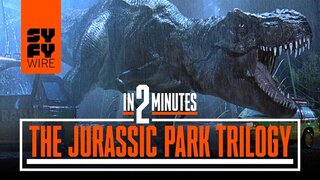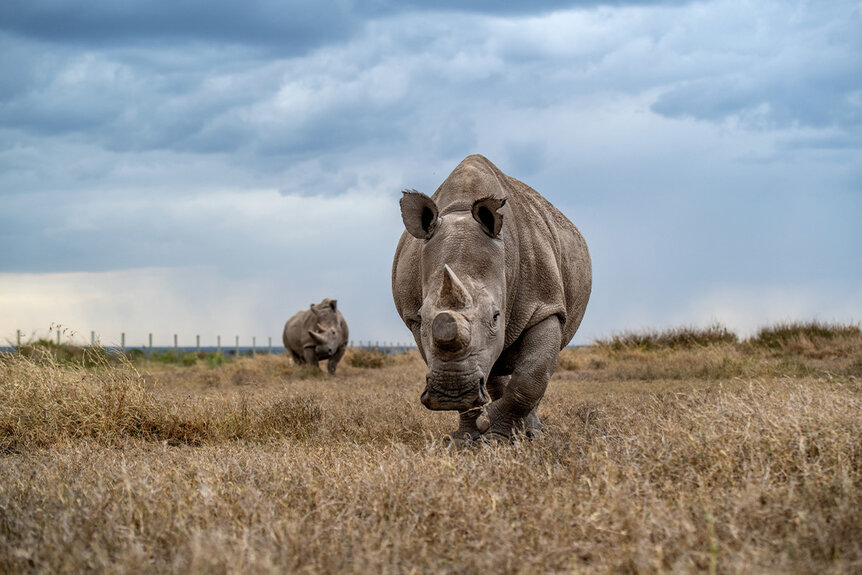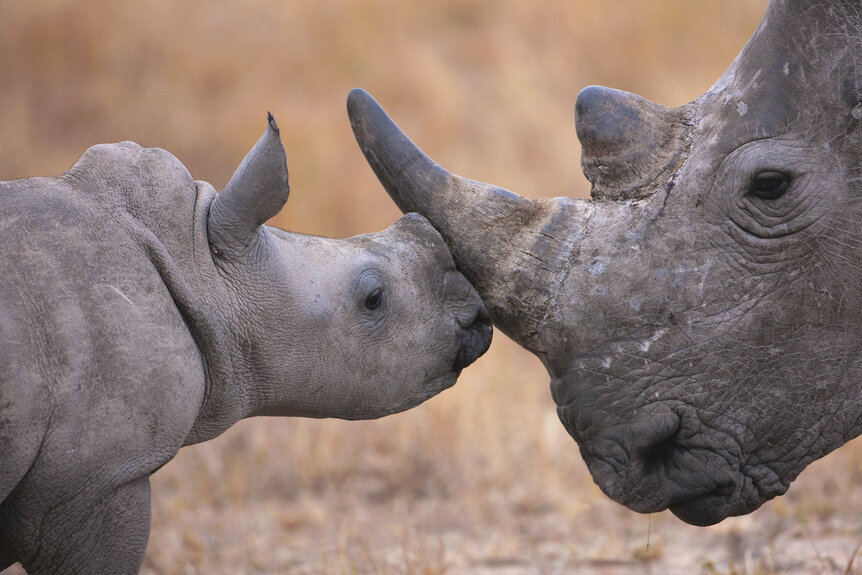Create a free profile to get unlimited access to exclusive videos, sweepstakes, and more!
Colossal Biosciences and BioRescue Partnering Up to Save Northern White Rhino from Extinction
Northern white rhinos are functionally extinct, Colossal and BioRescue plan to change that.
When Jurassic Park's John Hammond dreamed up his prehistoric theme park, filled with genetically crafted dinosaur-like creatures, he did so with an eye toward making a buck. Lots of them, actually. He wasn’t concerned with creating accurate representations of extinct species, recovering lost biodiversity, or responsibly maintaining the populations he had created. He was, however, very interested in funneling as many paying customers as possible through those oversized wooden doors, and that’s why he failed.
Any real world attempt at resurrecting extinct species must engage with the consequences of what that will entail. Where will those animals live? How might they impact ecosystems which have changed in their absence? And what responsibility do we have to maintain and care for populations of animals who only exist through our direct intervention? Perhaps most importantly, why bring back something like the mammoth or the dodo (or a dinosaur) when so many living species are on the verge of collapse? Those are questions we can only assume never crossed the minds of John Hammond or anyone else at InGen.
RELATED: De-Extinction Company Colossal Biosciences Commits to Resurrecting the Dodo
What if, instead, InGen had a corporate conscience and used their undeniably impressive set of genetic tools to drive innovation in wildlife conservation? That’s more or less the operating philosophy of the real-world de-extinction company Colossal Biosciences. The company has been developing de-extinction tools for years, and now it is partnering with BioRescue, a conservation organization determined to prevent the seemingly inevitable extinction of the northern white rhinoceros.
The Northern White Rhino Is Functionally Extinct, But Maybe Not For Long
To date, Colossal’s efforts have focused on a few alluring but extinct species. They have projects in progress to resurrect the woolly mammoth, the Tasmanian tiger, and the dodo. Announcing your intent to bring back animals that died out hundreds or thousands of years ago is the sort of thing that makes headlines and drives public interest; rest assured, Colossal does intend to bring those animals back, but it’s not the company’s only motive. See, any tool that could be used to gather DNA, analyze genomes, and resurrect a woolly mammoth could feasibly also be used on living or more recently lost species.
“Fundamentally, we want all of our technologies to be leveraged for conservation. It’s great early on in our journey to de-extinction that we can be working on species preservation along that path,” Ben Lamm, CEO of Colossal, told SYFY WIRE.
It's difficult to imagine a species closer to the brink than the northern white rhino. Today, the species is functionally extinct with only two living individuals, a mother/daughter pair named Naijin and Fatu. Both rhinos were born at the Czech ZOO Dvůr Králové but have been at Ol Pejeta Conservancy in Kenya since 2009.
Both living northern white rhinos are female and Naijin is no longer reproductively active. Even if she were, there aren’t any males. However, BioRescue has been working for years to preserve the northern white rhino’s genetic heritage by gathering sperm and egg cells from the last remaining individuals. Using that preserved genetic material and the closely related southern white rhino as surrogates, BioRescue hopes to bring new northern white rhinos to term and restore the species to its natural habitat.
RELATED: Frozen Lab-Grown Embryos, a Hail Mary for the Northern White Rhino
Having preserved cell lines from a number of deceased individuals and from the two remaining northern white rhinos gives the effort a considerable leg up over something like resurrecting a mammoth, but there are still significant challenges.
How to Save a Species When All the Males Are Dead
“We have the two living northern white rhinos… in addition, we have 10 other cell lines of other animals, mostly that were moved to zoos in Europe and the states about 35 years ago. Those are great, but the problem is when a population declines from several tens of thousands to 12, there is an immense loss of genetic diversity,” Matt James, Colossal’s Chief Animal Officer, told SYFY WIRE.
Building a robust population of northern white rhinos requires that we capture as much genetic diversity in their genome as possible. To that end, Colossal is mounting a massive effort to track down any existing northern white rhino specimens in museums or elsewhere. Hair, bones, and other biological materials could provide vital information to fill out the northern white rhino genome.
“Once we know what we’ve lost, we can design a program around conferring that lost diversity back into the living population,” James said.
The end game involves creating northern white rhino embryos in the lab, using preserved biological material. Then those embryos could be modified with gene editing tools to insert lost genetic diversity. Finally, the embryo would be implanted into a southern white rhino surrogate to carry the baby rhino to term. Eventually, Colossal hopes to develop artificial wombs capable of growing a rhino embryo (and a host of other living and extinct animals) from implantation to birth. Though, you might see your first mammoth before you see your first artificial womb.
“De-extinction doesn’t feel like science fiction to us because we’re so close to it. What does feel like science fiction is artificial wombs. What we’re trying to do is build a flexible system that can take a species from an embryo to term, and not just one species but a lot of species, and account for anything from 13.5 day gestation on one end to 22 months on the other end. I don’t have a timeline, but it will be a while,” Lamm said.
In the meantime, the collaboration between Colossal and BioRescue has already revealed some logistical opportunities for scientific collaboration at large. In particular, James notes there is no centralized database cataloguing the location, type, and condition of museum specimens. In order to gather as much genetic information about the northern white rhino as possible, James and the team have to meticulously chase down specimens all over the world. It’s not as glamorous as gene editing, but having a searchable database for what we collectively have would make lots of scientific work easier to accomplish.
RELATED: How Close Are We to Cloned Dinosaurs? The Science Behind Jurassic Park
“What we’re finding is there are process and collaboration improvement opportunities for global consortiums to make these projects. Outside of artificial wombs and genetic engineering and deep genomic sequencing and all of these things, there are fundamental collaboration components that will come from this and that’s really exciting,” Lamm said.
It’s unclear when or if the next northern white rhino will be born, but it’s more likely today than it was yesterday. And the lessons learned from the rhinoceros, the mammoth, and the dodo will extend to other species who aren’t in quite as much trouble. Colossal is building a metaphorical ship to ferry extinct species back to the land of the living, and along the way they’re tossing out lifeboats to species struggling to tread water.
John Hammond would never.
Kind of still want to go to Jurassic Park, though. See it for yourself, from Universal Pictures.
































